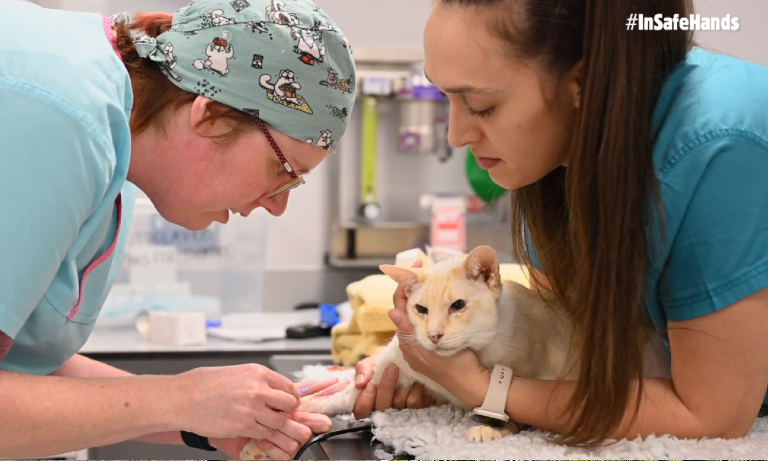#InSafeHands: changing the narrative
How you and your practice can support the campaign
#InSafeHands
How you and your practice can support the campaign
#InSafeHands
Vets and vet teams care deeply about animal welfare and take pride in delivering highly skilled care for patients and clients. However, recent media and social media coverage has seen high levels of criticism unfairly levelled towards veterinary professionals, questioning their motivations and priorities.
So, we’re changing the narrative by showing the public the realities of the incredible work vets deliver daily to help animal health and welfare.
We’re sharing the real-life stories and experiences of vets working across the profession. Spotlighting the important work you do day to day, from protecting the welfare of the nation’s pets to supporting farmers and food production, international trade, disease control and public health.
Use the digital resources and ideas available on this page to help spotlight the value of veterinary care and the dedication of the inspiring, skilled and hard-working vet teams across all sectors and specialisms, under the umbrella of #InSafeHands.

The campaign films have been designed to illustrate the breadth of work delivered by the UK’s vet community across a range of specialisms, workplaces and businesses. Collectively they demonstrate the wider story of the vet profession and by sharing these stories across your channels you can help provide the public with a greater understanding and positive insight into what it is to be a vet in the UK today.
Below is some short form copy you can use to promote the campaign films on your social media channels, website, by email, and in your newsletters or publications. You can also download our campaign toolkit in pdf format.
Using social media is a great way to promote your work and practice, both locally and to the wider world.
Please find a selection of posts that can be used on social media. Always use the hashtag #InSafeHands so we can engage and amplify your posts. This will also help us build momentum and track engagement.
Social media posts
We've put together a collection of captions that you can utilise during this campaign:
Social 1
If you’ve ever wondered why #vets fees cost what they do, this short film behind the scenes of a busy vet practice really shows what goes into caring for the nation’s animals. From the skilled professionals through to the high-tech equipment. #InSafeHands
Social 2
Amazing short ‘behind the scenes’ film of a vet practice that’s very similar to ours. It’s great to be able to show what goes into delivering care to our patients. #InSafeHands
Social 3
You knew vets take care of the nation’s pets but #DidYouKnow they play a critical role in UK food production, international trade along with managing disease control and public health. #InSafeHands
As well as posting across your social media, you can also embed on your website. Here's some supporting copy to help:
Vets and vet teams care deeply about the welfare of animals and take pride in delivering outstanding, highly skilled care for patients and clients. These short films share the real-life stories and experiences of vets working across the profession and the important work they do day to day, from protecting the welfare of the nation’s pets to supporting farmers and food production, international trade, disease control and public health.
#InSafeHands
Local media coverage can be an excellent way to market your veterinary practice and to promote the services you offer to local customers – all for free. You can use the tips below to get a story in the local media. Alternatively, send your ideas and case studies to the BVA media team ([email protected]), who will do the legwork for you.
What is the press interested in?
There are several options for generating local media coverage. BVA’s media guide for members offers simple tips and advice to help you achieve local press coverage. Here are some key takeaways:
What to include in a case study
You can pitch these stories to the media yourself, or reach out to the BVA media team who will be happy to help draft the case studies for you. Here’s the information you’ll need to provide for a case study:
Getting permission for your photos: if you are taking photographs for media or social media use, and these photos include identifiable images of members of the public or animals, including your clients or their animals, you must have their permission to use their image. If the image is of a minor under 18 years of age, you must have the permission of their parent or legal guardian. The RCVS Code outlines asking permission to use images of animals in paragraph 12.10.
Refer to BVA’s Pets in Advertising best practice guidance for tips on the responsible depiction of animals in all imagery.
Thank you for reading through this toolkit and we hope that the information contained within will be useful.
If you want to hear more about this campaign and find out how you can get involved, contact the BVA media team via [email protected].
The media team are happy to provide local press release templates, write out case studies, and help promote your stories to media in your region.
We look forward to seeing, reading and watching your communications activity. Please remember to use the campaign hashtags #InSafeHands so we can see and share your posts on social media.
For any queries or for further information, please contact [email protected].